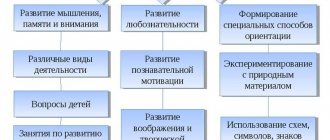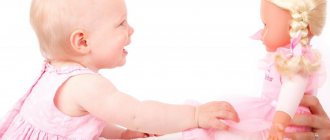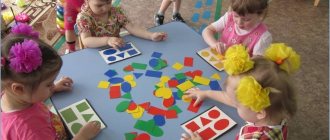In the first years of a child’s life, parents need to make every effort to ensure that the baby can train the abilities of his senses. To do this, it is very important to provide him with the full range of first impressions, thanks to which his psychophysical development will occur much faster and more efficiently. In other words, it is necessary to actively use methods aimed at the sensory development of the child, which we will talk about today.
Experts say that a child is born with natural abilities to understand the world through the perception of objects and phenomena. the growing baby no longer has enough natural abilities to fully Therefore, in the first years of a child’s life, parents need to make every effort to ensure that the baby can train the abilities of his senses, as well as improve them in the future.
To do this, it is very important to provide him with the full range of first impressions, thanks to which his psychophysical development will occur much faster and more efficiently. In other words, it is necessary to actively use methods aimed at the sensory development of the child, which we will talk about today.
What is sensory development and education?
Sensory development (sensory) is the process of forming certain ideas about the properties of objects: their size, shape, color, position in space, tastes, smells, etc. When a baby first encounters the diversity of shapes, colors and events around him (and this happens almost in the very first days of his life), it is important not to miss this time, to help him get used to this world and push him to self-improvement.
It is these goals that are fundamental in the sensory education of a child - a systematic, consistent introduction to the so-called sensory culture. Of course, even without the help of parents, the child, one way or another, knows the world as it is, but this knowledge, without proper sensory development, may turn out to be false or incomplete.
According to experts, sensory development, on the one hand, is the foundation for the overall mental development of the baby, and on the other hand, has a completely independent meaning as a way of developing sensations, perceptions and ideas in children. And it is precisely the early age that is most favorable for the accumulation and systematization of ideas about the world around us and the improvement of the activity of the child’s sense organs.
Sensory development at 1-2 years of age
The development of children 1-2 years old has its own specifics.
At one year and 1-3 months children:
- are able to distinguish between two objects that are different in size and identical in shape, quickly remember words and use them in moments of joy or movement;
- during the game, they reproduce previously learned movements (claps, stringing pyramid rings onto a rod, etc.);
- They begin to orient themselves in space, they can walk and change body position.
At this age, preschoolers perceive square and circle shapes best, as well as some colors (red, blue, green and yellow).
At one year and 3-6 months children:
- begin to distinguish between three objects that are different in size and identical in shape;
- name things and actions at moments of interest;
- among similar objects they can find two identical in meaning and different in other properties;
- learn to distinguish sounds by pitch and rhythm; at the moment of play they can reflect observed actions.
They navigate in space and walk at a side step, stepping over small obstacles.
At one year and 7-9 months children:
- from three or four objects of different shapes, they can choose the same ones according to a sample or the request of their parents;
- begin to understand short stories based on pictures;
- they themselves use two-syllable sentences in their speech;
- During the game they build houses.
Preschoolers begin to better perceive the shape of a triangle, rectangle and oval, as well as some colors (orange, blue, purple).
At one year and 10 months children:
- Based on a sample and a request, they can find two identical objects among objects of different colors;
- understand short stories based on events familiar to them;
- in speech they use simple sentences, use adjectives and pronouns;
- They begin to come up with simple story games (example: a doll dresses a doll).
Closer to three years, children develop ideas about the width, length and height of objects, and they begin to perceive differences in similar sounds.
Types of sensory sensations
Sensory sensations are classified into:
- visual (visual);
- tactile;
- olfactory;
- auditory;
- taste.
It is in accordance with them that the child develops concepts about:
- size;
- form;
- color;
- sounds;
- taste;
- smell.
How important is it to develop sensory perception?
Experts say that proper sensory education contributes to the harmonious development of a person. The value of sensory is highly valued due to the important results of this process:
- laying the foundations for the development of intelligence;
- laying the foundations of educational activities;
- creating the foundation of all types of memory (visual, tactile, long-term and others);
- increased attention;
- development of observation skills;
- formation of taste preferences;
- development of the aesthetic component;
- facilitating the baby’s compatibility with the real world;
- expanding children's vocabulary;
- development of a rich imagination.
Competent sensory exercises and activities contribute to the orderliness of the child’s ideas about the world around him, which can turn the usual picture of the baby’s life upside down. Therefore, it is so important to direct the perception of the world around us in the right direction from an early age.
Sensory education systems are based on various tasks in accordance with the age of the baby.
- At an early age, knowledge about sensory standards is collected.
- In middle preschool age this knowledge is formed. Children learn to examine objects, identify them into groups, and divide objects into individual quantities.
- For children of senior preschool age, the main task is to prepare for school education (the ability to distinguish sounds and perceive what is written on paper).
Main tasks of sensory
The main tasks of children's sensory development are:
- formation of correct sensory standards;
- formation of correct perceptual reactions (sensory perceptions);
- acquiring the skills to independently use a system of standards and correctly respond to perceptual processes.
It is important to understand that the sensory education of a child must take into account his age characteristics. With normal development, children under six months, as a rule, observe the movement of objects, make grasping movements, and show interest in bright toys and loud sounds. Over time, the baby begins to become interested in smells and tastes.
From one to three years, a child acquires basic knowledge about the signs of things around him. It is at this age that he develops concepts of shapes, colors, sizes, tastes and smells. In the fourth year of life, the main ideas about the characteristics of objects are mastered, as well as sensory standards . This is the beginning of an analytical perception of objects and events surrounding the child.
Sensory development at 3-4 years of age
By the age of three, preschoolers begin to ask questions “when?”, “who?”, “where?”, “why?”. In their games, they begin to try on roles for themselves and each other (example: the “daughter-mother” game), and in speech they actively use not only simple, but also complex sentences.
They begin to actively draw and transfer into their drawings what they saw earlier. They try to most accurately convey the main features of people, animals and the environment. Young children do not have spatial thinking and the concept of “perspective”, so all the figures on paper are most often the same size (a person is the same size as a house, etc.). Preschoolers cannot comprehend compositions with a lot of detail, so their drawings most often include from one to three figures.
Children's vocabulary increases, they can construct simple and complex sentences using various adjectives and pronouns, they begin to understand the meaning and meaning of words, their emotional connotation.
At the age of three, their knowledge of the color palette is replenished. Kids get acquainted with the concepts of “saturation”, “contrast”, “softness” and learn to distinguish shades of the same color.
Also at this stage of life, children are able to correctly interpret sounds of different character and pitch, they develop a sense of rhythm and understanding of music. They learn to distinguish intonations in the conversations of others and interpret them correctly.
At this age, they begin to study and describe the world around them in more detail and detail, actively touch everything and remember the nature of the surface of objects (smooth, rough, soft, etc.).
The main sensory signs of cognition of the world for children aged 1-4 years are shape, size and color. Their development requires activities that include various games.
Reference system for young children
Sensory standards for children at an early stage of development are considered to be:
- nine primary colors of the spectrum;
- five geometric shapes (square, triangle, rectangle, circle, oval);
- three sizes (sizes) of an object: large, medium, small;
- musical notes, sounds of the native language;
- four tastes (sweet, bitter, salty, sour);
- two temperature definitions (warm, cold);
- five types of smell (sweet, bitter, fresh, light, heavy).
Depending on the age of the baby, the requirements of sensory education require the following knowledge and skills.
For ages 1.5-2 years:
- understanding and ability to name 3-4 colors, as well as correctly select them according to the sample;
- orientation in the sizes (magnitudes) of objects, the ability to disassemble and assemble a three-dimensional matryoshka doll;
- the ability to correctly assemble a colored pyramid of 4-6 rings of different sizes;
- the ability to correctly correlate the configuration of three-dimensional figures with flat ones;
- have basic drawing skills (draw horizontal, vertical, short and long lines, and also clearly explain what he drew).
For ages 2-4 years:
- understanding and ability to name 6 colors, as well as correctly select them according to the sample;
- orientation in 3-5 contrasting values (sizes);
- the ability to assemble a colored pyramid of 6-8 rings of different sizes;
- the ability to correctly form a whole object from 4 parts (cut pattern, folding cubes);
- the ability to clearly distinguish between three-dimensional objects in shape (cube, ball, pyramid, etc.) and flat objects in outline (square, triangle, rhombus, circle);
- the ability to draw short and long lines of different locations within a sheet of paper.
MAGAZINE Preschooler.RF
Teacher Elena Konstantinovna Igolkina, MBDOU kindergarten No. 7 “Polyanka”, Kstovo, Nizhny Novgorod regionREPORT Topic “Sensory development of children of primary preschool age”
Working in an early childhood group, I realized that sensory development plays a huge role in a child’s development. Because on the one hand it forms the foundation of the child’s general mental development, on the other hand it has independent significance because full perception is necessary for successful learning in kindergartens, at school and for many types of work. In accordance with the current federal state requirements, in the basic general education program for children's education, the developmental function of education is highlighted, ensuring the formation of the child's personality and orienting the teacher to his individual characteristics. The program comprehensively presents all the main content areas of a child’s upbringing and education. A separate section in the educational activities “Cognition” is “Sensory Development”, which is aimed at developing cognitive interests in children of all age groups and at their intellectual development. Sensory development is a condition for successful mastery of any practical activity, and the origins of abilities lie in the general level of sensory development achieved in early preschool age. The period of the first 3 years is the period of the most intensive physical and mental development of children. Sensory development is aimed at teaching children to precisely and accurately perceive objects, their various properties and relationships (color, shape, size, pitch of sounds, etc.). Psychological research shows that without such training, children’s perception for a long time remains superficial and fragmentary and does not create the necessary basis for general mental development, mastery of various types of activities (drawing, construction, speech development, etc.) and full assimilation of knowledge and skills. Sensory development is the development of a child’s perception and the formation of his ideas about the external properties of objects: shape, color, size. Knowledge begins with the perception of objects and phenomena of the surrounding world. The sensory development of a child is the development of his perception and the formation of ideas about the external properties of an object - their shape, color, size, etc. One of the main tasks in achieving the goal of working with children to master the educational field of “Cognition”, the development of children’s cognitive interests, and the intellectual development of children is sensory development. In the pedagogical process of children's sensory development, there are such tasks as enriching children's direct sensory experience in different types of activities, hand movements on an object in the process of becoming familiar with it, finding similarities and differences between objects with the same names, and developing the ability to name the properties of objects. The means of sensory development for children are didactic games and exercises, visual activities (drawing, modeling, appliqué), design, play activities, etc. It’s easier for a child to remember when playing. The significance of sensory development is that it organizes the child’s chaotic ideas obtained during interaction with the outside world, develops attention, develops observation, is the basis for intellectual development, and ensures the assimilation of sensory standards. Young children begin to discover the world around them, absorbing streams of sensory information. During the first year of life, it is necessary to provide the baby with rich and varied external impressions and to develop attention to the properties of objects. By providing an influx of new impressions, sensory education contributes not only to the development of the senses, but also to the overall physical and mental development of the child. At the age of 2-3 years in a child’s life, the tasks of sensory education become significantly more complicated. Although the baby is not yet ready to assimilate sensory standards, he begins to accumulate ideas about color, size, and other properties of objects. It is important that these ideas be varied. Starting from the age of 3, the main place in the sensory development of children is occupied by familiarizing them with generally accepted sensory standards and ways of using them. Sensory standards are generally accepted examples of the external properties of objects. The assimilation of sensory standards is a long and complex process not limited to preschool childhood. The assimilation of sensory standards is their use as units of measurement when assessing the properties of objects. The assimilation of sensory standards occurs in 3 stages: Stage 1 - pre-standard - occurs in the 3rd year of life. The child begins to call triangular shapes roofs, and about round shapes he says that it is a ball. Those. when using one item, the other is used as a model. Stage 2 – concrete objects become the means of perception. Children master the basic colors of the spectrum, both in everyday life and through didactic games. A special place is occupied by standards of magnitude, because it is conditional. Any object cannot be large or small in itself; it acquires these qualities when compared with another. Stage 3 - at 4-5 years of age, children already own sensory standards and begin to systematize them. The teacher helps the child build a sequence of colors in the spectrum by recognizing their shades. At the level of perception, familiarization also occurs with variants of geometric shapes that differ in aspect ratio - short and long. Integration of the educational area of cognition has a connection with other educational areas, such as 1. Physical education - for example, the use of multi-colored pins (studying the spectrum of colors - go around the red pin, etc.) 2. Communication - it is necessary to talk more with children, for example, what is worth In our group, the closet is so big. How small the chair is, etc. 3. Artistic creativity is drawing with different colors of paints. 4. Reading fiction - for example, the fairy tale about Masha and the Three Bears, which describes the sizes large medium small. 5. Socialization is different types of games. During games, I teach children to perform basic work tasks, for example: Katya, put a small cube on a large one, or put a large doll on a large chair, etc. For the sensory development of children in my group, a developing subject environment has been created. We have a teaching table for playing with sand and water. Children really like to pour water from one bucket (red) to another (blue). Mix sand with water and use molds to make different shapes. There is a mummers corner where we hang aprons, skirts, and hats of different colors, sewn with our own hands. When changing clothes, children's ideas about color are reinforced (they put on a red skirt, a green hat, etc.). We also have a didactic table on sensory skills. There we have games such as pyramids of different sizes, labyrinths, puzzles, cut-out pictures of 2 parts and 4 parts, and other games purchased in the store. Working in an early childhood group, I made and created a lot of didactic materials for various topics and games on sensory development with my own hands. My teaching material is presented in the portfolio. I tried to maintain the aesthetics of the prepared didactic material. These are pure color tones, pleasant texture. (I published my material on various preschool websites, for which I received certificates of publication and took part in a monthly competition for the best educational game.) Taking into account the specifics of working with children, in order to achieve the goal, I use the method of repeating the same activities but using new material. For example - find a house for a cube - find a house for a ball. In order for the child to better understand everything that we give him in kindergarten, parents should also work with him at home. After communicating with parents at the meeting, it turned out that not all children know colors, shapes and not all of them study at home. A consultation was organized for parents on the topic “sensory development of young children”, I organized an exhibition of didactic games and manuals on object-based play activities, which you can not only buy in a store but also make with your own hands, for example, select by color, collect “fun beads”, screens for theaters, a track for balls, lacing, etc. We created a small library for parents in which we selected books on sensory development. (Raising a child’s sensory culture. Sensory room). Parents listened to our advice and began to bring material they created with their own hands to our group - skirts sewn by themselves, dolls with clothes, etc. I’ll tell you about the dynamics of diagnostic data in the “sensory development” section. Diagnosis of sensory development was carried out on the basis of diagnostic and mastery of the program. I used didactic games because they are close and understandable to children. In task 1, a game was set: Find a flower for a butterfly, the goal of which was to reveal the child’s ability to distinguish colors according to the principle of the same - not the same. call them red yellow blue green. In the 2nd task, the game is an entertaining box, the goal is to reveal the child’s knowledge about the shape (ball cube). In the 3rd task, a did.game, assemble a pyramid, the goal of which is to reveal the child’s ability to compare objects by size (big small. More is less, distinguish between one and many concepts. According to these 3 tasks, it was revealed that at the beginning of the school year, not all children mastered the program (the level of indicators was low). Taking into account the specifics of working with children, in order to achieve the goal, I use the method of repeating the same classes but using new material, and by the end of the year the level indicators have increased, but it is necessary to consolidate the material covered.
| Next > |
When and in what form is it necessary to accustom a child to sensory culture?
It has been scientifically proven that early sensory education has a positive effect on the level of intelligence and the quality of mental development of the child as a whole. Therefore, you need to start accustoming your baby to sensory culture as early as possible (the ideal option is from the age of one, when the baby is most inquisitive and tries to look at, touch, and taste everything).
But it is naturally impossible to force a child to develop and improve himself at this age. All classes must be conducted in the only form accessible to his understanding - the form of a game. However, the game should not tire the baby, otherwise he will quickly lose interest in it. 10-15, and in some cases even 5-7 minutes are enough for the child to take away something useful for himself from the lesson.
Sensory development of preschool children (4-5 years old)
In middle age, preschoolers begin to experience role-playing interactions in play. During play activities, children begin to realize that everything happens for the sake of the meaning of the game. This allows for the active development of visual activity. A special role is given to drawing. It becomes objective.
For example, a child at this age must realize that a person has eyes, a mouth, a nose, hair, fingers, and elements of clothing. There is an improvement in visual activities.
On a note! Children begin to draw shapes on their own, understanding their purpose, and master the skills of cutting with scissors and gluing parts. The concept of design is introduced.
The basics of sensory education for middle-aged children also include the following:
- Developing the skills to create buildings according to your own ideas.
- Development of both gross and fine motor skills.
- Particular attention is paid to the coordination of movements and dexterity of the child. He must have good balance, step over obstacles, and be able to play with the ball.
- Perception becomes more developed. Children should be able not only to recognize geometric shapes, but also to understand what objects are similar to them.
- The concepts of size, color, length and width are well developed.
- Orientation in space has been improved.
- Preschool children's memory capacity increases. They can remember eight names of objects. Voluntary memorization is formed. The child is already able to understand the task assigned to him, they remember the instructions given to them by their parents or educators.
- There is an active development of imaginative thinking. You can use schematic images to solve the problem assigned to you.
- Children can come up with a short fairy tale or story on their own. Awareness of the interaction of events develops.
- Attention becomes more stable. A child of four years old can already concentrate on one task for more than 15 minutes. When performing an action, he can remember the condition that must be met.
- Diction and pronunciation of sounds improves. Speech in children becomes more developed. At this age, speech disturbances that were previously observed may be corrected. The development of the grammatical aspect is progressing well.
- The child’s communication with adults changes significantly. It becomes more educational in nature. The child is increasingly interested in information that is difficult for him.
- From the age of 4 to 5 years, the need for respect from adults plays a major role in development. It is very important that parents and educators give praise.
Development of mental abilities and intelligence
Sensory development at this age is also reflected in relationships between peers. Selectivity appears, children are divided into separate groups. Leadership begins to emerge. Competitiveness is important for the development of a child’s own image.
Important! It is necessary to direct the development of middle-aged children in the right direction. Help them form the correct idea of their image, take a position among their peers in the group!
Development in drawing
Sensory development of children aged 5 years and older
At the age of five, the most critical age begins before preparing for school. Children already clearly know the concepts of shapes, colors, and are able to compare one object with another according to their properties. They have already accumulated significant experience in tactile sensations.
The task of educators and parents is to consolidate existing knowledge. At the age of 5 to 6 years, preschoolers are already able to play intellectual games. This should be actively used in educational activities. For example, you can arrange quizzes after each topic covered.
Chess, checkers and children's lotto are great for this age. This not only trains attentiveness, but also memory and logic. It is best to focus on group games and role-playing activities from the age of five.
On a note! Activities on learning the rules of the road can be used as educational games for preschoolers. Here you can come up with both quizzes and role-playing scenes. This method will help not only to effectively consolidate new material, but also to train sensory skills.
After the age of five, special attention should be paid to the communication abilities of children. This is an important aspect of education for future schoolchildren. To do this, you often need to use group work and collective creativity. The task of educators is to help a preschooler find his place among his peers.
Games for preschoolers
The role of parents in sensory education
Father and mother always play a big role in the child’s sensory development. It is parents who lay in the child’s brain the basis of knowledge and skills for later life. And how parents convey sensory standards to the child will determine his further successful education and life in general.
Experts believe that the ideal time to develop sensory skills is after 1 year of age. The baby becomes inquisitive, everything is quite interesting to him, and proper activities and games with the baby during this period will contribute to his harmonious psycho-emotional and mental development. During this period, the baby is ready to receive information about the world through the senses through direct interaction with an object. And at the first stage it is important to touch, look, smell, listen; at the next stage - compare, sort, contrast (by shape, size, weight, temperature, etc.). This is how standards and ideas about the basic properties of the environment (and the world as a whole) are formed - color, shape, size, weight, surface temperature, etc.
Teachers give parents some recommendations on the development of their child’s sensory senses.
- Daily conversations with your baby, retelling what you saw during the day and discussing events. All conversations must be accompanied by standards. For example, ask your little one to describe the color of the car he saw, the size of the tree outside the window, or the taste of the candy he bought.
- Be sure to answer all your child’s questions. However, the answers should not be generalized. Try to state the essence of this or that answer as clearly as possible for children.
- Teach your baby facial expressions of emotions (angry, cunning, sad, happy).
- Play pantomimes and show animal movements and sounds.
- Engage in physical activity and massage with your child daily. Tactile influence on certain points of the body stimulates mental activity.
- Engage in modeling, drawing, and playing in the sand with children of primary preschool age.
- Get a pet and teach your baby how to care for it (pour water, comb its fur, feed it).
- Buy or make toys and items for sensory development yourself. These can be bags of cereals or pebbles, panels with switches, buttons, ropes with scraps and beads.






